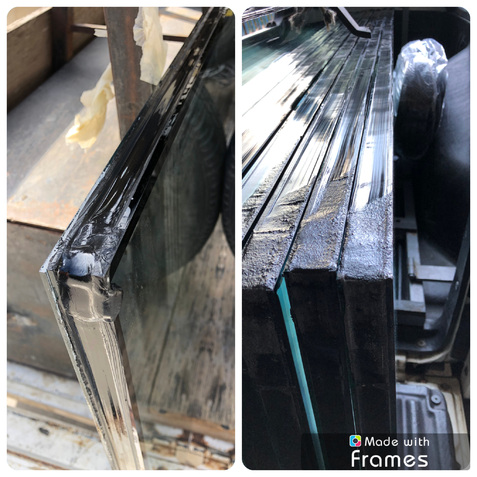Items list
Wednesday 02 Dec 2020
❗️ #ATTENTION In the offers of double glazing that you receive.. ❗️ The consumer must finally learn all the information about
the double glazing he pays to put in his frames and
compare according to the quality and certification of the manufacturer!
Basic Difference Cold Sulfur VS Hot Glue
The main difference, in the perimeter sealing of the Double Glazing,
between the outdated Hotmelt hot glue & the Two-component
Cold Sulfur glue lies in the way in which these two glues are
liquefied to take their final position between the two glasses.
The hot glue is initially in solid form (a black cube 6.5 kg) which
is placed in a bucket at a temperature of 160-190 ° C,
liquefied & through a nozzle (pistol) is placed around the
perimeter of the double glazing.
As soon as the hot glue comes out of the gun, it cools down & regains
its solid form.
As it is easily understood, this glue can become fluid again if
heated and, therefore, to create holes (small holes) from which
moisture will penetrate into the Double Glass, the well-known blur.
Also, the hot seal does not guarantee that the ARGON does not escape
from the gap between the glasses.
Watch the first video at the top.
The hot glue, due to high temperatures from the sun,
had become fluid again and peeled off. The double broke down and
needed to be replaced in just a few (2-3) years.
COLD SULFUR GLUE OF TWO INGREDIENTS.
Cold Sulfur Glue, on the other hand, assures us that
we will avoid the above two big problems of double glazing.
Documenting the reasons why this is the case, we report that
Cold Sealing is performed with two components which are mixed in
a ratio of 1:10.
The sulfur and the catalyst are in liquid form (imagined as large
containers of honey), which are mixed in a ratio of 1 to 10 inside
the spiral of the pistol & come out of it in liquid form of high
density to seal the gap in the perimeter between two windows.
Cold Sealing, does not polymerize (harden) immediately and usually
takes from 30 'to & 3 hours, depending on weather conditions.
Cold Sealing, when solidified, can never be liquefied again in
the future since on the one hand no heat is used to liquefy it and
on the other hand the two mixed materials can no longer be refined.
This definitively avoids:
Detachment Phenomena
Moisture Penetration (Blurring)
Escape ARGON
❗️❗️❗️ We are the -documented- UNIQUE company in Achaia State that uses:
* Kömmerling Cold Glue ™
* Double Butyl Sealing
* 4 Seasons Soft Glazed Energy Window Saint Gobain Planistar Evo ™
* Grace Silicates ™
* Argon instead of Oxygen in the Gap
Valid & Updated CE Certification for the production line of
Article:
Garoufalis P. Efthimis
* Economist, BSc Economics University of Patras
* Exports Manager "Garoufalis Glass"
* Specialization in Energy Double Glazing Topics
* Specialization in performance studies of Thermal Insulation / Sound Reduction through Glazing.


